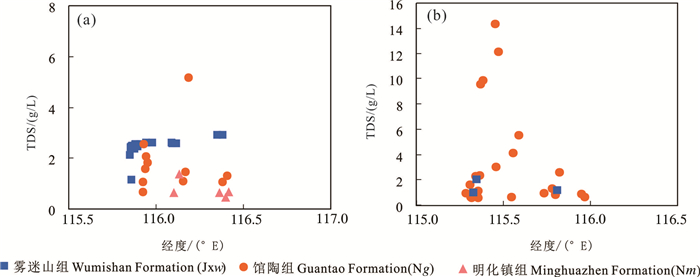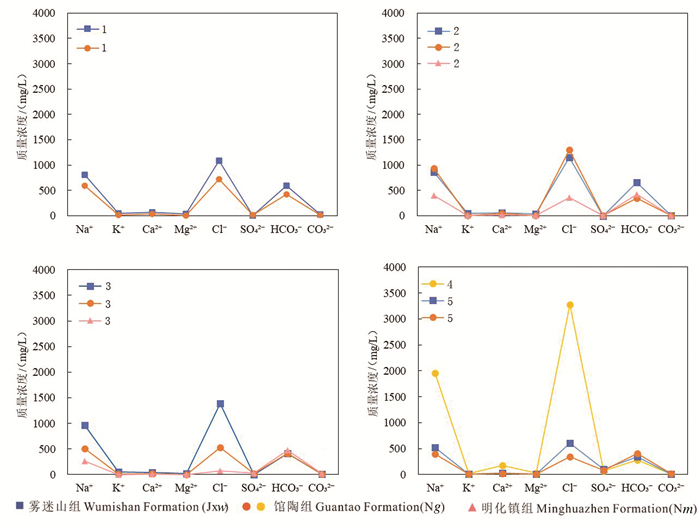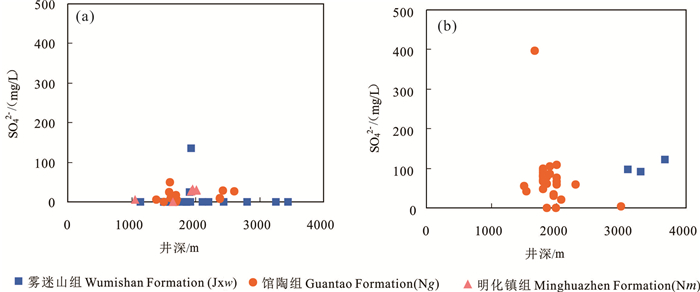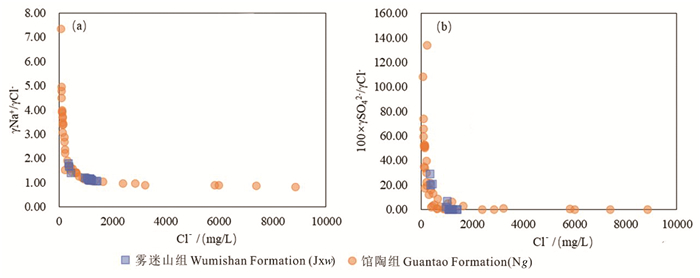Chemical field of geothermal water in Xiong'an New Area and analysis of influencing factors
-
摘要:
研究目的 雄安新区地热水化学场特征及其影响因素对了解区域地热资源聚敛机制具有重要意义。
研究方法 在区内5个主要构造单元(容城凸起、牛驼镇凸起、霸县凹陷、保定凹陷和高阳低凸起)开展地热水水化学采样和测试分析工作。
研究结果 研究区内主要分布有砂岩热储和岩溶热储,水化学类型以Cl-Na型和Cl·HCO3-Na为主。从浅入深,地热水TDS值呈增大趋势。自西向东,地热水TDS含量表现为增大的趋势,指示着地下水流向。受断裂带导水作用影响,部分深部雾迷山组与馆陶组地热水发生混合现象。雾迷山组岩溶热储地热水的变质系数和脱硫系数低,热储封闭性较好,处于相对还原状态,而馆陶组和明化镇组砂岩热储地热水封闭性相对较差。
结论 区内地下水化学场主要受水岩相互作用程度、断裂、储层封闭性等因素影响。研究成果对于认识雄安新区地热资源、科学合理开发利用地热能,推进北方地区冬季清洁取暖具有重要意义。
Abstract:This paper is the result of geothermal geological survey engineering.
Objective The hydrochemical formation and evolution of the geothermal water in the Xiong'an New Area have great significant implications to understand the formation mechanism of geothermal resource.
Methods Geothermal water and cold groundwater in the Rongcheng uplift, Niutuozhen uplift, Baxian depression, Baoding depression, and Gaoyang low uplift were sampled for hydrochemical analyses.
Results There are two thermal reservoirs: Sandstone and karst thermal reservoirs. The main hydrochemical types were Cl·HCO3-Na and Cl-Na. The TDS values of geothermal water increased with well depths. Mixing of the geothermal water of the Wumishan Formation and the Guantao Formation was observed in the fault zone. The metamorphic coefficients and desulfurization coefficients of geothermal water in the Wumishan Formation were low, indicating a relatively closed thermal reservoir and reduced state, while the sealing of the reservoirs in the Guantao Formation and Minghuazhen Formation was relatively poor.
Conclusions The chemical field of geothermal water in the study area is controlled by the extent of water-rock interaction, faults, the sealing of the reservoirs, and so on. Our result is of great significance for understanding the geothermal resources in Xiong'an New Area and promoting clean heating in winter in northern China.
-

-
图 7 雄安新区地热水水化学成因模式示意图(修改自Cui et al., 2019)
Figure 7.
表 1 各单元水化学特征(平均值)
Table 1. Hydrochemical characteristics of each unit (average value)
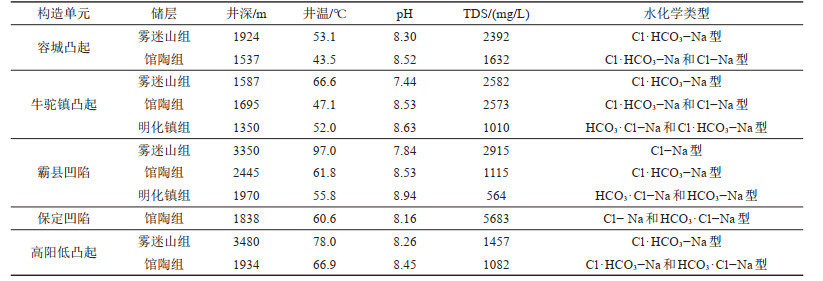
-
Chen Moxiang. 1988. Geothermal Energy in North China[M]. Beijing: Science Press.
Cui Yue, Zhu Chuanqing, Qiu Nansheng, Tang Boning, Guo Sasa. 2019. Radioactive heat production and terrestrial heat flow in the Xiong'an Area, North China[J]. Energies, 12: 4608. doi: 10.3390/en12244608
Cui Yue. 2020. Genetic Mechanism of Geothermal Resource Heat Source in Wumishan Formation of Xiong'an New Area[D]. Beijing: China University of Petroleum (Beijing).
Feng Xin, Zhang Yazhe. 2014. Analysis and research on ion proportion coefficient of groundwater in Shenzhou area[J]. China Rural Water and Hydropower, (4): 18-20, 24(in Chinese with English abstract). doi: 10.3969/j.issn.1007-2284.2014.04.006
Giggenbach W F. 1988. Geothermal solute equilibria. Derivation of Na-K-Mg-Ca geoindicators[J]. Geochimica et Cosmochimica Acta, 52(12): 2749-2765. doi: 10.1016/0016-7037(88)90143-3
Guo Qi, Pang Zhonghe, Wang Yingchun, Tian Jiao. 2017. Fluid geochemistry and geothermometry applications of the Kangding high-temperature geothermal system in eastern Himalayas[J]. Applied Geochemistry, 81: 63-75. doi: 10.1016/j.apgeochem.2017.03.007
Guo Qinghai, Wang Yanxin, Liu Wei. 2007. Major hydrogeochernical processes in the two reservoirs of the Yangbajing geothermal field, Xizang, China[J]. Journal of Volcanology and Geothermal Research, 166(3/4): 255-268.
Guo Sasa, Zhu Chuanqing, Qiu Nansheng, Tang Boning, Cui Yue, Zhang Jiatang, Zhao Yuhang. 2019. Present geothermal characteristics and influencing factors in the Xiong'an New Area, North China[J]. Energies, 12(20): 1-22.
Guo Sasa, Zhu Chuanqing, Qiu Nansheng, Tang Boning, Cui Yue. 2020. Formation conditions and favorable areas for the deep geothermal resources in the Xiong'an New Area[J]. Acta Geologica Sinica, 94(7): 2026-2035(in Chinese with English abstract). doi: 10.3969/j.issn.0001-5717.2020.07.011
Han Zheng, Cui Yiqiao, Wang Shufang, Li Xiao, Sun Ying. 2015. Geothermal resource assessment based on Monte-Carlo method——A case study of geothermal field in Xiong County of Hebei Province[J]. Urban Geology, 4: 58-62(in Chinese with English abstract).
Jiang Haiyang, Wang Shuxing, Liu Lian, Cao Yanling, Shi Meng, Li Tingting, Sun Wenguang. 2018. Hydrochemical and environmental isotope characteristics of geothermal resources in Linyi section of Yishu fault zone[J]. Land and Resources of Shanghai, 39(4): 90-94(in Chinese with English abstract).
Kong Yanlong, Pang Zhonghe, Pang Jumei, Li Jie, Pan Sheng. 2020. Fault-affected fluid circulation revealed by hydrochemistry and isotopes in a large-scale utilized geothermal reservoir[J]. Geofulids, 2020(24): 1-13.
Li Hu, Xia Lingxiao, Jiang Guosheng. 2015. Analysis and research on ion proportion coefficient of Ordovician geothermal fluid in Tianjin[J]. Groundwater, 37(5): 35-37(in Chinese with English abstract). doi: 10.3969/j.issn.1004-1184.2015.05.011
Li Kewen, Bian Huiyuan, Liu Changwei, Zhang Danfeng, Yang Yanan. 2015. Comparison of geothermal with solar and wind power generation systems[J]. Renewable and Sustainable Energy Reviews, 42: 1464-1474. doi: 10.1016/j.rser.2014.10.049
Li Yanyan, Zhang Baojian, Xing Yifei, Wang Guiling. 2021. Study on the fracture law of carbonate rocks of Gaoyuzhuang Formation under different confining pressures in Gaoyang geothermal field of Xiong'an New Area[J]. Geology in China: 1-15[2021-04-19] https://kns.cnki.net/kcms/detail/11.1167.P.20210419.1328.006.html (in Chinese with English abstract).
Liu Mingliang, He Tong, Wu Qifan, Guo Qinghai. 2020. Hydrogeochemistry of geothermal waters from Xiong'an New Area and its indicating significance[J]. Earth Science, 45(6): 2221-2231.
Ma Feng, Wang Guiling, Zhang Wei, Zhu Xi, Zhang Hanxiong, Yue Gaofan. 2020. Thermal storage space structure and resource potential of Rongcheng geothermal field in Xiong'an New Area[J]. Acta Geologica Sinica, 94(7): 1981-1990(in Chinese with English abstract). doi: 10.3969/j.issn.0001-5717.2020.07.007
Pang Jumei, Pang Zhonghe, Lü Min, Tian Jiao, Kong Yanlong. 2018. Geochemical and isotopic characteristics of fluids in the Niutuozhen geothermal field, North China[J]. Environmental Earth Sciences, 77(1): 12. doi: 10.1007/s12665-017-7171-y
Pang Zhonghe, Kong Yanlong, Pang Jumei, Hu Shengbiao, Wang Jiyang. 2017. Research on geothermal resources and development and utilization in Xiong'an new area[J]. Journal of Chinese Academy of Sciences, 32(11): 1224-1230(in Chinese with English abstract).
Wang Guiling, Gao Jun, Zhang Baojian, Xing Yifei, Zhang Wei, Ma Feng. 2020. Research on thermal reservoir characteristics and high productivity geothermal well parameters of Wumishan Formation in Gaoyang low uplift area of Xiong'an New Area[J]. Acta Geologica Sinca, 94(7): 1970-1980(in Chinese with English abstract).
Wang Guiling, Liu Yanguang, Zhu Xi, Zhang Wei. 2020. Current situation and development trend of geothermal resources in China[J]. Earth Science Frontiers, 27(1): 1-9(in Chinese with English abstract).
Wang Guiling, Wang Wanli, Zhang Wei, Ma Feng, Liu Feng. 2020. The status quo and prospect of geothermal resources exploration and development in Beijing-Tianjin-Hebei region in China[J]. China Geology, 3(1): 173-181. doi: 10.31035/cg2020013
Wang Guiling, Zhang Wei, Lin Wenjing, Liu Feng, Zhu Xi, Liu Yanguang, Li Jun. 2017. Study on the accumulation model and potential of geothermal resources in Beijing Tianjin Hebei region[J]. Geology in China, 44(6): 1074-1085(in Chinese with English abstract).
Wang Jiyang, Gong Yulie, Lu Zhenneng, Ma Weibin. 2013. Looking at China's geothermal development and utilization from the perspective of European geothermal development[J]. Advances in New and Renewable Energy, 1(1): 1-6(in Chinese with English abstract).
Wang Jiyang, Pang Zhonghe. 2021. Geothermal energy welcomes unprecedented development opportunities[N]. China Science Daily, 2021-01-06(1).
Wang Jiyang, Qiu Nansheng, Hu Shengbiao, He Lijuan. 2017. Progress and development trend of geothermal research in China's oil fields[J]. Earth Science Frontiers, 24(3): 1-12(in Chinese with English abstract).
Wang Jiyang. 2015. Geothermy and its Application[M]. Beijing: Science Press: 257-376(in Chinese).
Wang Jiyang. 2020. Clean geothermal heating is promising[N]. China Science Daily, 2020-09-02(2).
Wang Zhuting, Zhang Chao, Jiang Guangzheng, Hu Jie, Tang Xianchun, Hu Shengbiao. 2019. Characteristics and genetic mechanism of current geothermal field in Xiong'an New Area[J]. Chinese Journal of Geophysics, 62(11): 4313-4322(in Chinese with English abstract). doi: 10.6038/cjg2019M0326
Xia Liangyu, Zhang Yabo. 2019. An overview of world geothermal power generation and a case study on China-The resource and market perspective[J]. Renewable and Sustainable Energy Reviews, 112: 411-423. doi: 10.1016/j.rser.2019.05.058
Yan Xiaoxue, Gan Hao, male, Yue Gaofan. 2019. Hydrogeochemical characteristics and genesis analysis of typical geothermal fields in Huizhou Conghua, Guangdong[J]. Geological Review, 65(3): 743-754(in Chinese with English abstract).
Zhang Meng, Lin Wenjing, Liu Zhao, Liu Zhiming, Hu Xiancai, Wang Guiling. 2014. Hydrogeochemical characteristics and genetic model of Gulu high-temperature geothermal system in Xizang[J]. Journal of Chengdu University of Technology (Science &Technology Edition), 41(3): 382-392(in Chinese with English abstract). doi: 10.3969/j.issn.1671-9727.2014.03.15
Zhao Xingang, Wan Guan. 2014. Current situation and prospect of China's geothermal resources[J]. Renewable and Sustainable Energy Reviews, 32: 651-661. doi: 10.1016/j.rser.2014.01.057
Zhou Cheng, Elham Doroodchi, Behdad Moghtaderi. 2013. An in-depth assessment of hybrid solar-geothermal power generation[J]. Energy Conversion and Management, 74: 88-101. doi: 10.1016/j.enconman.2013.05.014
Zhou Zongying, Liu Shiliang, Liu Jinxia. 2015. Characteristics and development countermeasures of China's geothermal resources[J]. Journal of Natural Resources, 30(7): 1210-1221(in Chinese with English abstract).
陈墨香. 1988. 华北地热[M]. 北京: 科学出版社.
崔悦. 2020. 雄安新区雾迷山组地热资源热源成因机制[D]. 北京: 中国石油大学(北京).
冯欣, 张亚哲. 2014. 深州地区地下水离子比例系数分析研究[J]. 中国农村水利水电, (4): 18-20, 24. doi: 10.3969/j.issn.1007-2284.2014.04.006
郭飒飒, 朱传庆, 邱楠生, 唐博宁, 崔悦. 2020. 雄安新区深部地热资源形成条件与有利区预测[J]. 地质学报, 94(7): 2026-2035. doi: 10.3969/j.issn.0001-5717.2020.07.011
韩征, 崔一娇, 王树芳, 李潇, 孙颖2015. 基于蒙特卡洛法的地热资源评价-以河北省雄县地热田为例[J]. 城市地质, 4: 58-62 doi: 10.3969/j.issn.1007-1903.2015.04.011
江海洋, 王树星, 刘连, 曹艳玲, 史猛, 李婷婷, 孙文广. 2018. 沂沭断裂带临沂段地热资源水化学及环境同位素特征[J]. 上海国土资源, 39(4): 90-94. doi: 10.3969/j.issn.2095-1329.2018.04.019
李虎, 夏玲晓, 江国胜. 2015. 天津地区奥陶系地热流体离子比例系数分析研究[J]. 地下水, 37(5): 35-37. doi: 10.3969/j.issn.1004-1184.2015.05.011
李燕燕, 张保建, 邢一飞, 王贵玲. 2021. 雄安新区高阳地热田热储高于庄组碳酸盐岩不同围压下破碎规律研究[J]. 中国地质: 1-15[2021-04-19] https://kns.cnki.net/kcms/detail/11.1167.P.20210419.1328.006.html.
马峰, 王贵玲, 张薇, 朱喜, 张汉雄, 岳高凡. 2020. 雄安新区容城地热田热储空间结构及资源潜力[J]. 地质学报, 94(7): 1981-1990. doi: 10.3969/j.issn.0001-5717.2020.07.007
庞忠和, 孔彦龙, 庞菊梅, 胡圣标, 汪集暘. 2017. 雄安新区地热资源与开发利用研究[J]. 中国科学院院刊, 32(11): 1224-1230.
汪集暘, 龚宇烈, 陆振能, 马伟斌. 2013. 从欧洲地热发展看我国地热开发利用问题[J]. 新能源进展, 1(1): 1-6. https://www.cnki.com.cn/Article/CJFDTOTAL-XNYJ201301002.htm
汪集暘, 庞忠和. 2021. 地热能迎空前发展机遇[N]. 中国科学报, 2021-01-06(1).
汪集暘, 邱楠生, 胡圣标, 何丽娟. 2017. 中国油田地热研究的进展和发展趋势[J]. 地学前缘, 24(3): 1-12. https://www.cnki.com.cn/Article/CJFDTOTAL-DXQY201703002.htm
汪集暘. 2015. 地热学及其应用[M]. 北京: 科学出版社: 257-376.
汪集暘. 2020. 地热清洁取暖大有可为[N]. 中国科学报, 2020-09-02(2).
王贵玲, 高俊, 张保建, 邢一飞, 张薇, 马峰. 2020. 雄安新区高阳低凸起区雾迷山组热储特征与高产能地热井参数研究[J]. 地质学报, 94(7): 1970-1980. https://www.cnki.com.cn/Article/CJFDTOTAL-DZXE202007006.htm
王贵玲, 刘彦广, 朱喜, 张薇. 2020. 中国地热资源现状及发展趋势[J]. 地学前缘, 27(1): 1-9. https://www.cnki.com.cn/Article/CJFDTOTAL-DXQY202001002.htm
王贵玲, 张薇, 蔺文静, 刘峰, 朱喜, 刘彦广, 李郡. 2017. 京津冀地区地热资源成藏模式与潜力研究[J]. 中国地质, 44(6): 1074-1085. http://geochina.cgs.gov.cn/geochina/article/abstract/20170603?st=search
王朱亭, 张超, 姜光政, 胡杰, 唐显春, 胡圣标. 2019. 雄安新区现今地温场特征及成因机制[J]. 地球物理学报, 62(11): 4313-4322. https://www.cnki.com.cn/Article/CJFDTOTAL-DQWX201911026.htm
闫晓雪, 甘浩男, 岳高凡. 2019. 广东惠州-从化典型地热田水文地球化学特征及成因分析[J]. 地质论评, 65(3): 743-754. https://www.cnki.com.cn/Article/CJFDTOTAL-DZLP201903020.htm
张萌, 蔺文静, 刘昭, 刘志明, 胡先才, 王贵玲. 2014. 西藏谷露高温地热系统水文地球化学特征及成因模式[J]. 成都理工大学学报(自然科学版), 41(3): 382-392. https://www.cnki.com.cn/Article/CJFDTOTAL-CDLG201403015.htm
周总瑛, 刘世良, 刘金侠. 2015. 中国地热资源特点与发展对策[J]. 自然资源学报, 30(7): 1210-1221. https://www.cnki.com.cn/Article/CJFDTOTAL-ZRZX201507013.htm
-



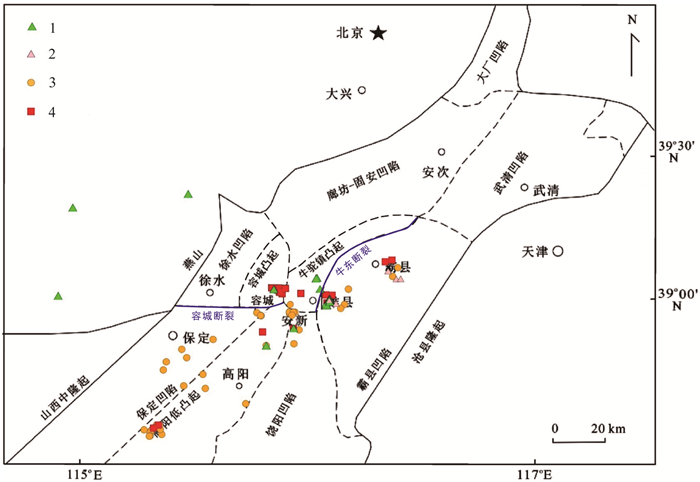
 下载:
下载:

